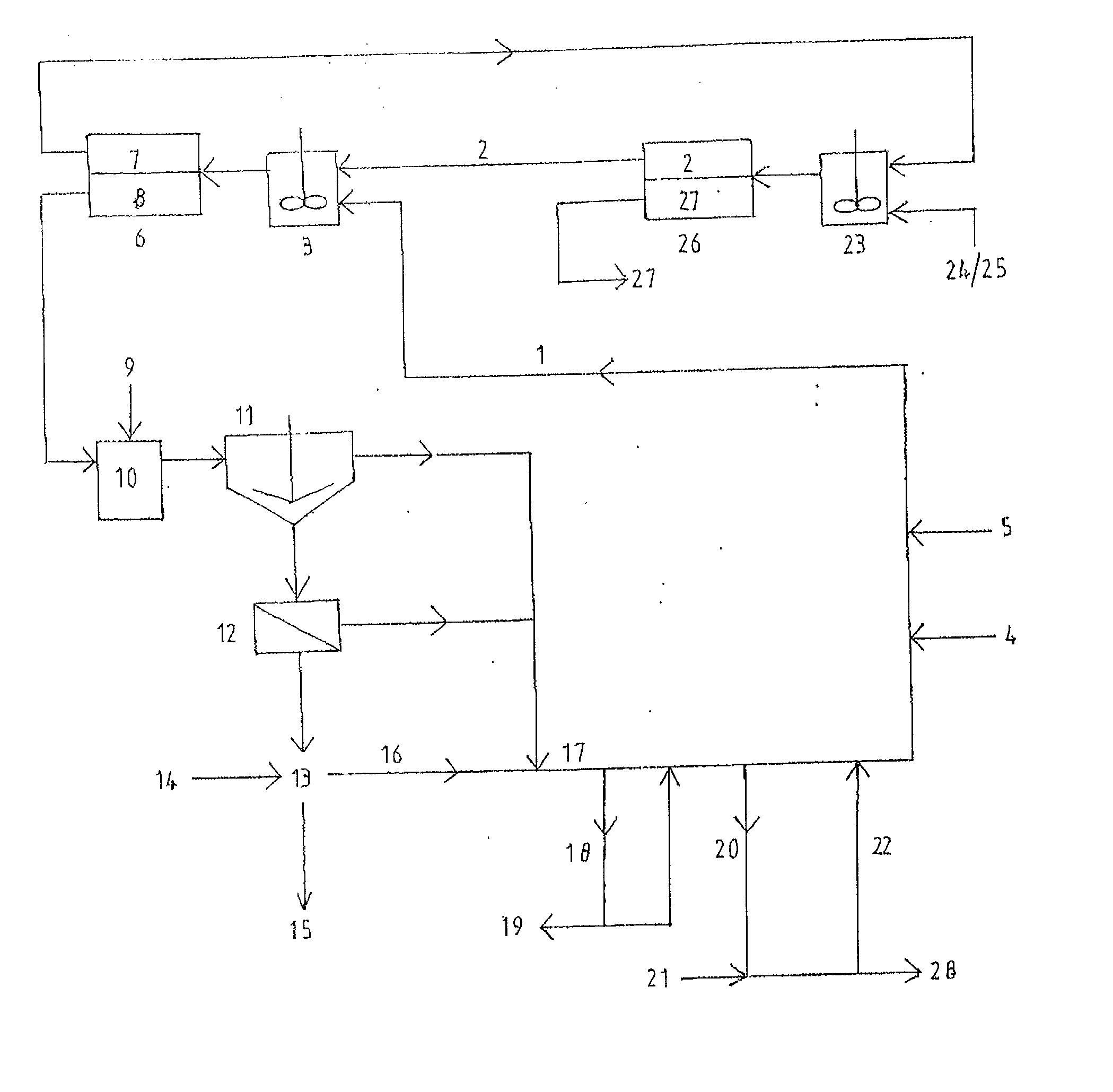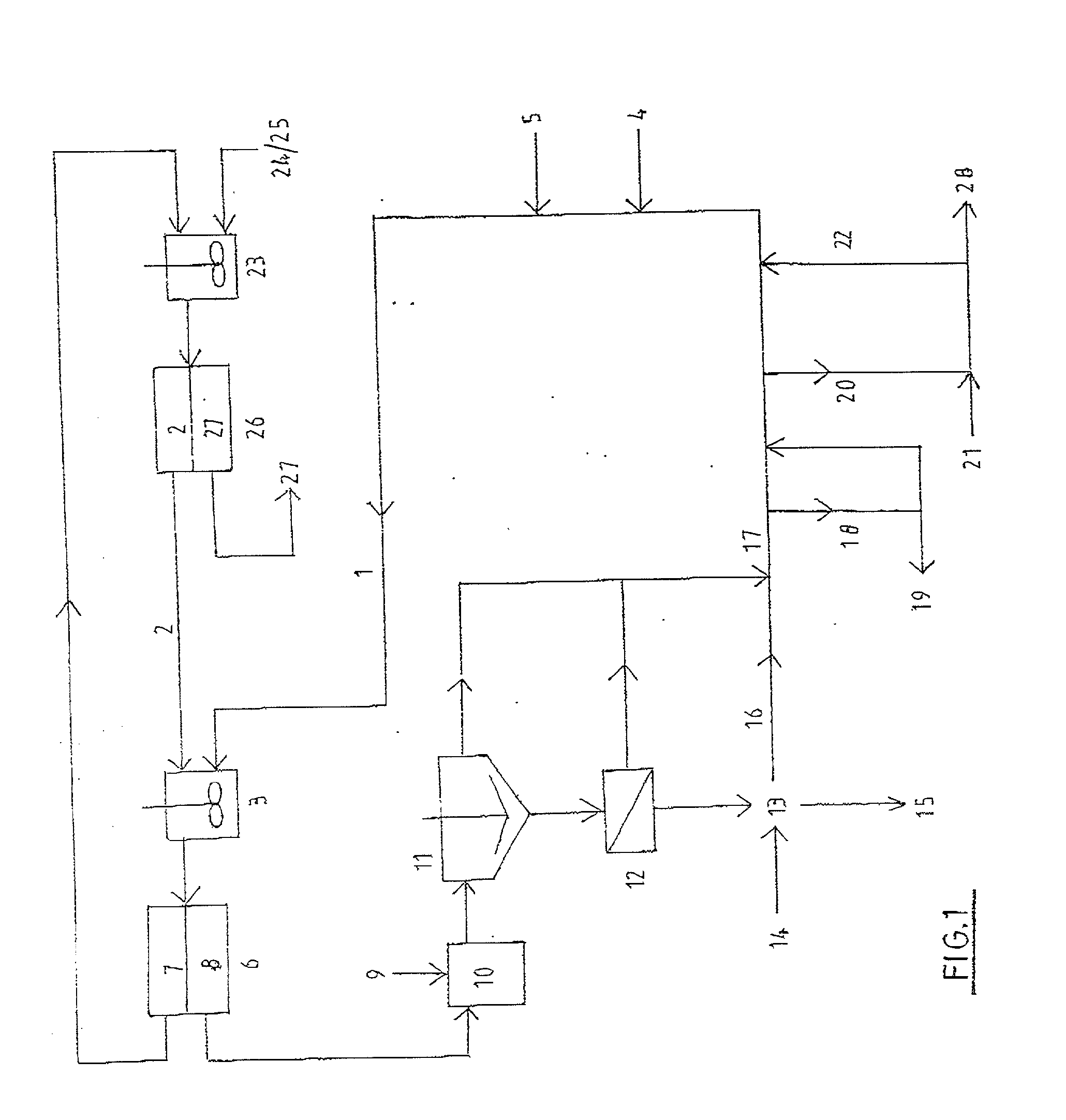Process for extraction of metals
a metal and processing technology, applied in the field of metal processing, can solve the problems of difficult treatment and disposal of acid mine drainage, unfavorable environmental protection and human health, and often harmful solutions, and achieve the effect of more flexibility
- Summary
- Abstract
- Description
- Claims
- Application Information
AI Technical Summary
Benefits of technology
Problems solved by technology
Method used
Image
Examples
example 1
[0187] This example illustrates the selective loading of magnesium over calcium into the organic extractant CYANEX 272 using Method B. The example uses a slurry of magnesium chloride, acetate buffer, and basic magnesium carbonate for loading magnesium ions into the organic extractant, followed by acid stripping to produce a magnesium chloride brine essentially free of calcium ions.
[0188] An aqueous solution containing .apprxeq.30 wt % MgCl.sub.2, .apprxeq.0.24 M acetate buffer and 0.035 M to 0.05 M sulphate ions was saturated with respect to gypsum (CaSO.sub.4.2H.sub.2O.sub.(S)) at .apprxeq.30.degree. C.
[0189] Magnesium feedstock composed of basic magnesium carbonate and calcium carbonate was added to form a slurry containing 120 g of feed solids per liter of 30 wt % MgCl.sub.2 solution. The mole ratio of magnesium to calcium in the feed solids was .apprxeq.50:1.
[0190] Also added was the mole equivalent of concentrated sulphuric acid (98 wt %) sufficient to match the calcium content...
example 2
[0194] This example illustrates the use of Method B to selectively leach (pre-dissolve) MgO.sub.(S) in the presence of CaCO.sub.3(S) using a triethanolamine buffer, followed by loading magnesium into the organic extractant CYANEX 272 and hydrochloric acid stripping of the loaded organic phase to produce a magnesium chloride brine essentially free of calcium ions.
[0195] An aqueous solution containing .apprxeq.1.8 M triethanolamine hydrochloride buffer, 2,310 mg / L of magnesium ions as MgCl.sub.2, and 1.1 mg / L of calcium ions has a pH of 5.41 at 40.degree. C.
[0196] A mixture containing .apprxeq.90 wt % MgO.sub.(S) and .apprxeq.10 wt % CaCO.sub.3(S) having a mole ratio of magnesium to calcium of .apprxeq.22.4:1, was added to the above solution to form a slurry containing initially .apprxeq.2.54 wt % solids. Since the buffer was in its acidic form, leaching of MgO.sub.(S) ensued.
[0197] After 60 minutes of agitation, significant leaching of MgO.sub.(S) had occurred and the aqueous solutio...
example 3
[0201] This example illustrates the use of Method B to produce magnesium chloride brine and hexahydrate crystal essentially free of calcium ions, by the combined use of magnesium sulphate and calcium carbonate as the feed materials.
[0202] An aqueous solution containing .apprxeq.30 wt % MgCl.sub.2, .apprxeq.0.24 M acetate buffer and 0.036 M to 0.05 M sulphate ions was saturated with respect to gypsum (CaSO.sub.4.2H.sub.2O.sub.(S)) at .apprxeq.40.degree. C.
[0203] Calcium carbonate feed material was added to form a slurry containing .apprxeq.74 g of feed solids per liter of 30 wt % MgCl.sub.2 solution. The slurry was agitated for 10 min in order to wet the feed solids.
[0204] A sample of 38 wt % CYANEX 272 in Exxsol D80 (diluent) was contacted with the above slurry at an organic to aqueous ratio of .apprxeq.2.5:1 for 6 min at .apprxeq.40.degree. C. During mixing, carbon dioxide gas was liberated.
[0205] After mixing, both phases separated within 60 seconds. The aqueous phase contained on...
PUM
 Login to View More
Login to View More Abstract
Description
Claims
Application Information
 Login to View More
Login to View More - R&D
- Intellectual Property
- Life Sciences
- Materials
- Tech Scout
- Unparalleled Data Quality
- Higher Quality Content
- 60% Fewer Hallucinations
Browse by: Latest US Patents, China's latest patents, Technical Efficacy Thesaurus, Application Domain, Technology Topic, Popular Technical Reports.
© 2025 PatSnap. All rights reserved.Legal|Privacy policy|Modern Slavery Act Transparency Statement|Sitemap|About US| Contact US: help@patsnap.com



